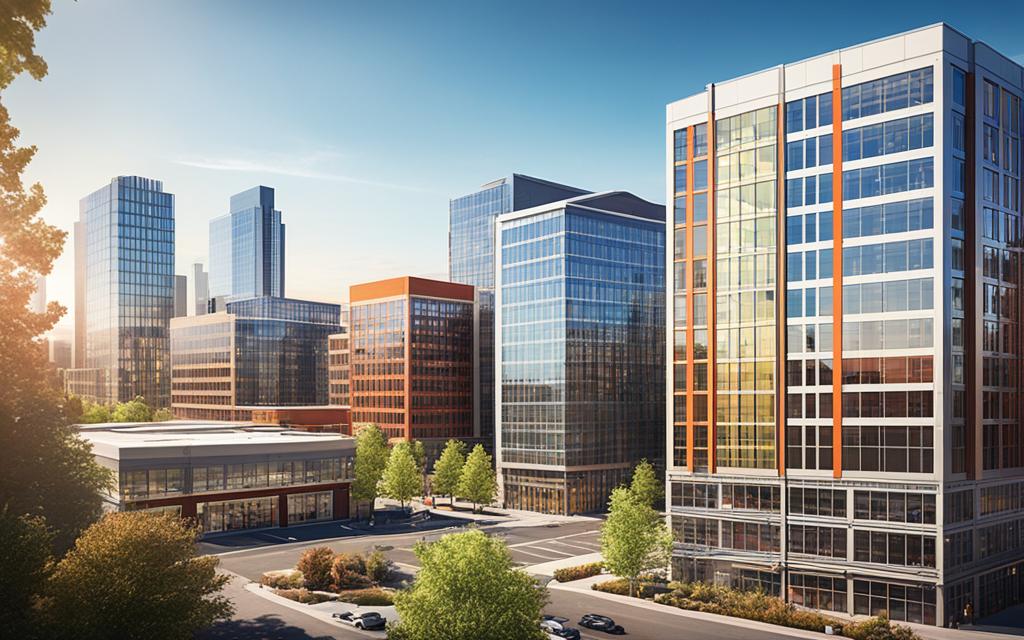
The landscape of Singapore’s commercial real estate is poised for a compelling transformation. The 2024 commercial real estate market forecast unveils a complex interplay between evolving economic pressures and emerging market opportunities. Industry experts are meticulously charting the course ahead, understanding that in this dynamic environment, a meticulous commercial real estate industry forecast is more crucial than ever.
Ermengarde Jabir, a seasoned economist, highlights the significance of the year ahead for Singapore. With challenges such as fluctuating interest rates and rising construction costs, each maneuver in the property market necessitates strategic finesse. Nonetheless, despite these impediments, the Singapore commercial property market analysis predicts a horizon lined with growth prospects and innovation-driven pathways.
State of the Commercial Real Estate Market in 2024
The landscape of commercial real estate market research consistently evolves, offering a complex view in the year 2024 where asset classes display disparate trajectories. Singularly robust are multifamily units and neighborhood retail which continue to bolster the industry with their resilience. On the opposite spectrum, a notable deceleration is observable within the industrial sector, prompting strategic reassessments.
Amidst this varied performance, the office real estate also presents an interesting puzzle, dictated by the preferences of tenants inclined towards premium workspaces. This, in turn, sows seeds of vulnerability for Class B and C buildings potentially slipping into obscurity. Therefore, a significant aspect of commercial real estate predictions hinges on technological and environmental innovation, encouraging conversions of underperforming office spaces into lucrative housing or tech centers.

Rigorous market research reveals a necessity to navigate these diverse asset classes with vigilance, particularly paying heed to emergent market trends. An emphasis on tech upgrades and sustainability measures indicates a broader industry trend of adaptation and nimble strategic maneuvers. By forecasting demand shifts and proactively reforming physical spaces, stakeholders can position themselves advantageously in this transformative phase of the commercial real estate market.
- Asset Class Diversification: Assessing performances sector-wise to identify stability and risk.
- Technological Integration: Embracing tech innovations to stay competitive and relevant.
- Environmental Forwardness: Prioritizing sustainability as a critical element of modern real estate development.
- Adaptive Reuse: Repurposing outdated spaces into desirable living or tech-focused real estate.
- Demand Anticipation: Responding to shifts in market needs with informed, strategic decisions.
2024’s commercial real estate market thus becomes a tapestry of both challenges and opportunities, demanding from participants astuteness and agility as they tread a path marked by unpredictable yet potentially rewarding paradigms.
Commercial Real Estate Market Forecast and Growth Projections
The trajectory of Singapore’s commercial real estate market remains a focal point for investors and developers as they navigate through the quagmire of economic uncertainties. While projections vary, the overall outlook aligns with the understanding that judicious investment strategies and the ability to adapt to market changes will circumvent the complex dynamics at play.
Industrial and Logistics: A Sector Showing Initial Signs of Softening
The industrial and logistics sectors have been harbingers of growth in the commercial real estate landscape, but recent trends indicate a mild downturn. Despite this, certain segments such as cold storage and distribution maintain robust projections. Moody’s Analytics CRE provides an optimistic view, forecasting an annual rent growth ranging from 5% to 6% over the next decade, marking steady progress in the face of headwinds.
Interest Rates and Impact on Property Investment
Interest rates exert a prominent influence on property investments, with fluctuations impacting the cost of borrowing and investor returns. The volatility of the five-year Treasury yield in the last quarter of 2023 heightens the complexity of forecasting. Savvy market players are keeping a keen eye on the Federal Reserve’s moves, as any future rate cuts could redefine investment strategies and outcomes for the year ahead.
Insights from Industry Experts: Analyst Predictions for 2024
Expert analysts offer a narrative that can be aptly described as a “Tale of Two Halves.” The anticipation of a dichotomous year, with initial economic headwinds giving way to a potential rebound, is shaping the commercial real estate outlook for 2024. The narrative stems from expectations that the easing of CPI-inflation and subsequent rate cuts, especially in the Asia Pacific region, will foster a climate ripe for recovery and innovation within the commercial real estate sector.

In conclusion, the future of commercial real estate in Singapore, while confronting challenges, also brims with potential for growth and transformation. With informed projections and strategic planning, stakeholders can rise to meet the ebbs and flows of the market, and harness the opportunities that undoubtedly lie within the commercial real estate sphere.
Commercial Real Estate Predictions for Key Asset Classes

The landscape of commercial real estate in 2024 is set to reflect a complex tapestry of evolving commercial property trends and strategic responses to them. Foremost in the commercial real estate analysis is understanding how different asset classes are predicted to fare. A granular look into each category reveals a rich tableau of prospects and predicaments that investors and developers will need to navigate.
-
Office Spaces: The once vibrant office towers in central business districts are facing tides of transformation. High vacancy rates attributed to the new work-from-home cultures continue to cast long shadows, suggesting that more innovative and adaptable use of these spaces is necessary. Repurposing these assets could lead the charge in reviving these pivotal areas.
-
Industrial Sector: Moving at a more measured pace than in previous years, the industrial realm is poised to play a long game with hopes of sustained health. The shift towards logistics and specialized storage facilities seems a viable path forward for this stalwart of commercial real estate.
-
Neighborhood Retail: Contrary to many a doomsayer’s predictions, neighborhood retail spaces are showing remarkable resilience in the age of e-commerce. Their secret lies in their deeply embedded roots in local communities and their understanding of consumer behaviors in proximity to their market.
-
Multifamily Segment: While still a robust category, the luxury apartment niche seems to be hitting a soft patch. Strategies pivoting towards meeting the demands for more affordable and middle-market housing options may mitigate the cooling of this segment’s once heated market.
The year 2024 promises a spectrum of commercial real estate challenges and opportunities. The palpable shifts within key asset classes will undoubtedly shape the decisions of savvy investors, pushing the boundaries of traditional market analysis and opening doors to creative investment and development tactics.
Trends Influencing Commercial Real Estate in 2024
As the commercial real estate market strides into 2024, several key trends are emerging as critical drivers of change. Stakeholders who navigate these market trend projections and adapt swiftly to the trends influencing the future of commercial real estate can attain enhanced profitability and sustainability in an ever-evolving landscape.

Neighborhood Retail: Adapting to the Evolving Consumer Behavior
Despite the proliferation of e-commerce, neighborhood retail remains a bastion of resilience in the commercial property market. With a deep-rooted tradition of serving local communities and providing immediate customer satisfaction, these retail spaces continue to defy broader market trends. Existing formats are being re-imagined to enhance customer experiences and integrate seamlessly with online shopping phenomena—a testament to the sector’s adaptability and enduring appeal.
Multifamily Real Estate: Addressing the Shift in Housing Demand
While multifamily units persistently attract investors and renters alike, there is a noticeable shift from high-end luxury apartments to more value-focused accommodations. This trend reflects a broader demographic change and evolving financial realities. In reaction, developers and property managers are reassessing their offerings to provide amenities and price points that align with current housing market demands.
Office Space Evolution: Adapting to New Work Cultures
In response to the transformative impact of hybrid work environments, the office space sector is undergoing a metamorphosis. Emphasis is on creating adaptable and tech-infused spaces that cater to dynamic work patterns and support the well-being of employees. Innovative design solutions are being adopted to foster collaboration, connectivity, and productivity within the evolving corporate milieu.
Proactive Strategies for Commercial Real Estate Success
In navigating the commercial real estate terrain of 2024, industry players in Singapore must adopt a stance characterized by agility and a keen directional sense. As the landscape evolves, robust commercial real estate strategies become paramount to achieving real estate market success. Entrepreneurs and investors alike should remain vigilant and poised to quickly capitalize on the turnover of distressed assets, especially in instances where rate fluctuations present advantageous acquisition potential.
The pressing shortage of affordable housing creates a fertile ground for innovative development solutions. By embracing cutting-edge construction technologies and advocating for favorable regulatory frameworks, stakeholders can effectively respond to this need. Furthermore, proptech emerges as a vital component for industry advancement, offering a spectrum of capabilities from streamlined digital transactions to the implementation of smart building systems that redefine efficiency and occupant experience.
Amid escalating energy costs, a strategic pivot towards sustainable solutions is not just beneficial but essential. Investment in green infrastructure, such as solar panels and water reclamation, answers the dual call of environmental stewardship and economic prudence. Success in the commercial real estate domain for 2024 and beyond hinges on the capacity to anticipate market trends and deploy forward-thinking initiatives that yield long-term, sustainable growth.

